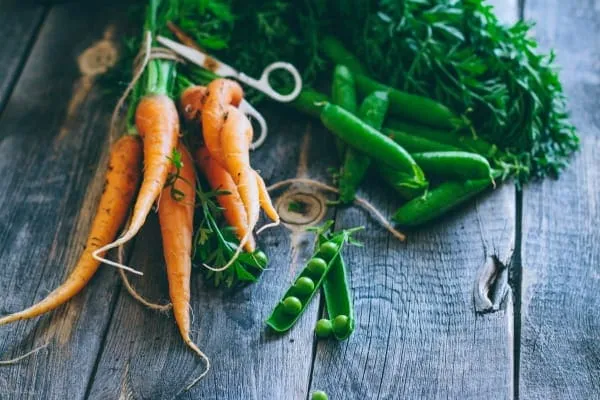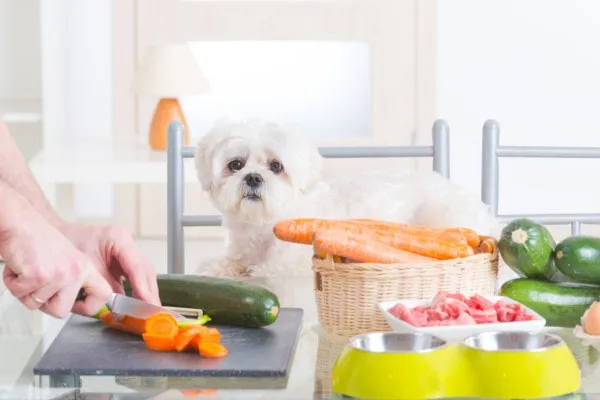As a pet parent, you’ve likely wondered, “What Human Vegetables Can Dogs Eat?” While our canine companions have different nutritional requirements than we do, many nutrient-rich vegetables can make excellent, healthy snacks for dogs. From crunchy treats to digestive aids, incorporating the right veggies into your dog’s diet can offer numerous health benefits. However, it’s crucial to know which vegetables are safe, how to prepare them, and, most importantly, which ones to avoid.
Integrative veterinarian Dr. Julie Buzby emphasizes that vegetables are beneficial for dogs at all life stages, from energetic puppies to wise senior canines. Understanding the best options can help you enhance your dog’s diet safely and deliciously. This guide from Dog Care Story will help you navigate the world of dog-friendly vegetables, ensuring your furry friend enjoys the best nature has to offer. Many healthy human foods can be beneficial for your dog, and understanding what human foods are healthy for dogs is a great first step.
What are Some of the Benefits of Giving Dogs Vegetables?
Adding vegetables to your dog’s diet, either as occasional snacks or as supplements to their regular meals, comes with a host of advantages. These natural treats are packed with vitamins, minerals, and fiber, contributing to overall well-being.
- Weight Management: For overweight dogs, low-calorie vegetable treats can be incredibly beneficial. They help dogs feel full faster, reducing the likelihood of overeating. Dr. Buzby often suggests a “green bean diet,” adding a portion of green beans to meals to help manage hunger while decreasing calorie intake.
- Digestive Health: The fiber in vegetables is essential for promoting a healthy digestive tract and optimal anal gland function, while also aiding in the prevention of constipation.
- Immune Health: Vegetables are rich in vital nutrients like Vitamin C, which can significantly boost the immune system and help ward off illnesses.
- Diabetes Management: Certain vegetables can assist in regulating blood sugar levels, making them a suitable dietary addition for dogs with diabetes.
- Antioxidants: Many vegetables are natural sources of antioxidants, compounds that help reduce the risk of various diseases and support cellular health.
- Training Rewards: Crunchy vegetables, such as carrots, can serve as excellent, motivating, and healthy rewards during training sessions.
14 Vegetables Safe for Dogs to Eat
It’s a common misconception that all human foods are off-limits for dogs. In reality, many vegetables are not only safe but also highly beneficial. Before introducing any new food into your dog’s diet, always ensure it is safe. Here are 14 top veterinarian-recommended vegetables you can share with your canine companion.
1. Pumpkin
Despite the ongoing debate about whether it’s a fruit or a vegetable, pumpkin firmly holds the top spot on many lists of dog-safe options. It’s a powerhouse for senior dogs, particularly due to its high fiber content which can help combat various stool problems. If your dog experiences diarrhea, the fiber can help solidify the stool by absorbing excess water. Conversely, for constipated canines, the added fiber encourages healthy bowel movements.
Pumpkin also contains linoleic acid, an omega-6 fatty acid known for its anti-inflammatory properties, especially beneficial for your dog’s skin. Cooked or canned pumpkin (plain, not pie filling) is the best way to serve it. Introduce it by mixing one to two tablespoons with their regular food. Don’t be surprised if your dog’s stool turns a slightly orange hue.
 A small dog patiently sitting at a table, looking expectantly at a piece of food.
A small dog patiently sitting at a table, looking expectantly at a piece of food.
2. Broccoli
Broccoli is another excellent vegetable that dogs can eat safely. It’s an outstanding source of fiber and also provides Vitamin C, which is crucial for a robust immune system. It’s best served cooked without any seasonings. Small pieces of raw broccoli stalks are also acceptable and offer a satisfying crunch that many dogs enjoy, making them a great low-calorie snack. To prevent choking, always serve bite-sized pieces, especially for smaller breeds. It’s important to feed broccoli in limited quantities, as excessive amounts can irritate the esophagus and stomach lining, potentially leading to discomfort or gas.
3. Carrots
Carrots are a highly favored vegetable for dogs. They are rich in potassium, Vitamin B6, and an excellent source of beta-carotene. This compound, responsible for carrots’ vibrant orange color, is converted into Vitamin A in your dog’s body, which is essential for immune function and vision. A deficiency in Vitamin A can even lead to night blindness.
Many dog owners prefer serving carrots steamed or boiled. A one-ounce serving contains only ten calories, making them a filling, low-calorie option, ideal for dogs needing to lose weight. Raw carrots are also a popular crunchy treat. Always supervise your dog and serve appropriately sized pieces to prevent choking. While healthy, carrots are naturally high in sugar, so they should be avoided for diabetic dogs.
 An owner gently offering a vibrant orange carrot to her dog, who is about to take a bite.
An owner gently offering a vibrant orange carrot to her dog, who is about to take a bite.
4. Green Beans
Green beans are a fantastic source of vitamins A, C, and K, as well as essential minerals like iron and calcium. Their low-calorie, high-fiber content makes them incredibly beneficial for dogs, especially those managing diabetes or needing to lose weight, as they promote fullness without adding many calories.
Green beans can be served boiled, steamed, or chopped. Crucially, avoid adding any seasonings, and steer clear of canned green beans that often contain high levels of salt. Start with a small amount, two to three green beans a day, ensuring treats don’t exceed ten percent of their diet unless advised otherwise by your vet.
5. Kale and Spinach
Dark leafy greens such as spinach and kale are excellent choices for your dog due to their rich nutrient profile. These vegetables are high in:
- Calcium: Essential for strong, healthy bones.
- Vitamin K: Vital for blood clotting.
- Vitamin A: Supports good vision.
- Iron: A key component of hemoglobin, which carries oxygen in red blood cells.
- Folate: Necessary for nutrient absorption in the small intestines.
Both kale and spinach can be served steamed or raw, always without seasonings. One or two raw leaves make a great snack, or you can shred them and add them to your dog’s meal. Due to kale’s high calcium content, excessive amounts can contribute to urinary problems and bladder stones. As with all treats, moderation is key. Consult your veterinarian if your dog is prone to bladder stones or has metabolic conditions.
 A cheerful beagle dog eagerly awaiting a treat, sitting attentively.
A cheerful beagle dog eagerly awaiting a treat, sitting attentively.
6. Brussels Sprouts
Brussels sprouts are another fiber-rich vegetable, packed with vitamins C and K, and trace minerals like magnesium, which supports cellular metabolism and muscle function. When preparing them, avoid oils or seasonings. Start by offering one or two at a time. Too many Brussels sprouts can lead to gassiness, bloating, and abdominal discomfort. Serve them steamed or boiled and cut each one into smaller pieces, as whole, round Brussels sprouts can pose a choking hazard for small and medium-sized dogs.
7. Zucchini
Zucchini is a good source of calcium, iron, magnesium, and fiber, all contributing to a healthy gastrointestinal tract. It can be served raw or steamed. Steaming makes it softer and easier to chew for dogs who prefer a less crunchy texture. Begin with three to four slices. It’s imperative to avoid zucchini prepared with seasonings or salad dressings, as many contain garlic and onions, which are toxic to dogs. Some dressings also include xylitol (or birch sugar), which is extremely poisonous to dogs and can cause severe hypoglycemia, seizures, liver failure, and even death. Knowing what is good for my dog to eat is key for their health.
8. Sweet Potatoes
Sweet potatoes are a flavorful, high-fiber food often found in commercial dog foods. They are an excellent source of vitamins A, B6, and C. If served raw, they should be chopped into small cubes. Steaming or roasting them makes them softer, tastier, and reduces the choking risk. Introduce sweet potatoes by giving three or four slices at a time. Similar to carrots, sweet potatoes have a high sugar content, so they should be limited or avoided for overweight and diabetic dogs.
9. Peas
Snow peas and sugar peas are fantastic for your dog! They provide good amounts of vitamins A and B, and minerals such as potassium, magnesium, and zinc, which are crucial for a healthy immune system and thyroid function. To prepare, steam or boil them. A one-ounce serving contains only twenty calories, making them a perfect low-calorie snack.
 A selection of fresh carrots and various other safe vegetables for dogs arranged on a rustic wooden table.
A selection of fresh carrots and various other safe vegetables for dogs arranged on a rustic wooden table.
Avoid canned peas due to their high salt content. Peas also contain purines, a type of protein, so dogs with urinary incontinence or kidney issues should generally avoid them.
10. Corn
Often viewed as a “filler,” corn actually offers several nutritional benefits and is commonly found in dog food. It provides easily digestible carbohydrates for energy, linoleic acid (an essential nutrient for healthy skin, coat, and immune system that dogs cannot produce on their own), and rich fiber for digestive health.
While corn kernels are safe, corn on the cob is not. The cob is indigestible and can cause an intestinal obstruction requiring emergency surgery. Only serve steamed kernels, ensuring they are free of seasonings or butter.
11. Celery
Celery, like many other safe vegetables, is low in calories, fat, and cholesterol, making it an excellent treat for dogs on a diet. It should be thoroughly washed and fed raw. Dogs who enjoy a good crunch often love celery, though its milder flavor might not appeal to all.
12. Cooked White Potatoes
Cooked white potatoes are safe for dogs and are a good source of vitamin C, B6, iron, and magnesium, important for the immune and nervous systems. The key word is “cooked.” Raw potatoes are toxic because they belong to the nightshade family and contain solanine, which cooking removes. Solanine can cause stomach upset, vomiting, and bloating. For more information on what cooked vegetables are good for dogs, consult reliable sources.
13. Cauliflower
Cauliflower is a super vegetable packed with healthy nutrients, including fiber, vitamin K, antioxidants, vitamins A and C, beta-carotene, and minerals like potassium, calcium, and magnesium. It can be fed cooked or raw, cut into bite-sized florets. While a great dietary addition, moderation is important due to its high fiber content, which can cause choking or an upset stomach if consumed in large quantities.
14. Beets
Beets are one of the most antioxidant-rich vegetables, with 88% water content, folate, fiber, vitamin C, and essential minerals. They are highly beneficial for your dog’s skin and coat health. Don’t be alarmed if you notice a pink or red tint in your dog’s urine after they eat beets; this is due to their natural pigment. If discoloration persists for more than 48 hours after discontinuing beets, consult your veterinarian. Considering what food can a maltese dog eat often includes similar considerations for safe vegetables.
 A small white dog sitting expectantly at a table while a person's hand cuts up fresh vegetables, including carrots.
A small white dog sitting expectantly at a table while a person's hand cuts up fresh vegetables, including carrots.
What Vegetables Should Dogs Not Eat?
While many vegetables are beneficial, some can be dangerous or even toxic to dogs. Knowing which ones to avoid is just as important as knowing which ones to feed.
1. Onions, Garlic, Chives, and Shallots
Vegetables belonging to the Allium family are highly toxic to dogs because they can damage red blood cells, leading to anemia. This family includes:
- Onions
- Garlic
- Chives
- Shallots
If your dog consumes any of these, contact your veterinarian immediately, even if symptoms (which can take days to appear) are not yet present. Emergency treatment may be required.
2. Mushrooms
It’s generally safest to avoid giving any mushrooms to your dog. While some types might be less harmful, others can cause severe gastrointestinal distress (diarrhea, stomach pain, nausea) or, even worse, life-threatening illnesses such as liver failure, kidney disease, lethargy, and seizures. Wild mushrooms, in particular, can be very dangerous as many toxic species resemble harmless ones. To eliminate risk, it’s best to keep all mushrooms away from your dog. On a related note, knowing what is the one meat all dogs should avoid can also help prevent serious health issues.
3. Unripe Tomatoes
Like potatoes, tomatoes are part of the nightshade family. The toxins within this family, mainly solanine, are most concentrated in unripe (green) tomatoes and the plant itself (leaves and stems). Therefore, dogs should never consume any part of a tomato plant or unripe tomatoes. If your dog ingests a tomato plant, contact your veterinarian immediately. Clinical signs of toxicity can include gastrointestinal upset (vomiting, diarrhea), dilated pupils, depression, decreased energy, and an increased heart rate.
4. Any Vegetables That Pose a Choking Hazard
Throughout this article, the importance of cutting vegetables into bite-sized pieces and properly cooking certain types has been emphasized to prevent choking. Choking is a serious emergency. Fibrous, hard-to-chew vegetables like raw cauliflower and celery require extra caution. Always supervise your dog when they are eating vegetable treats to ensure their safety.
How Do I Prepare Vegetables for Dogs to Eat?
The best way to prepare vegetables for your dog varies depending on the type of vegetable, how your dog prefers to eat, and its consistency. Experimenting with different preparation methods can help you discover what your dog enjoys most. For instance, while some dogs might turn their nose at raw broccoli, they might love it steamed!
Here are some general preparation ideas for serving vegetables as snacks:
Raw
Raw vegetables are convenient and portable treats. Baby carrots, for example, are a favorite for many dogs. When feeding raw veggies, thorough cleaning is paramount. Unlike cooked vegetables, raw ones are not exposed to high temperatures that kill bacteria and microbes. Proper washing and scrubbing are essential to remove dirt and pesticides.
Steamed
Steaming is an excellent method for preparing vegetables for dogs. It’s quick, easy, and helps preserve valuable nutrients.
- Always wash vegetables thoroughly before steaming.
- Chop them into uniform, bite-sized pieces to ensure consistent cooking.
- Once steamed, allow them to cool completely before offering them to your dog to prevent burns.
Steamed vegetables are cooked just enough to soften them slightly while retaining a crisp texture.
Boiled
For dogs with sensitive mouths or missing teeth, boiled vegetables can be a good option as they are softer and easier to chew than raw or steamed varieties. Keep in mind that boiling involves higher temperatures and submerging vegetables in water, which can slightly reduce their nutrient density. The same tips for washing and cooling apply to boiled vegetables.
Other Ways to Prepare Vegetables for Dogs
If your dog isn’t keen on whole or chopped vegetables, or if you want to get creative, consider these alternatives:
- Pureed: Blend thoroughly washed vegetables until they reach an applesauce-like consistency. Many dogs prefer this texture, and pureed vegetables can be easily mixed into their regular dog food.
- Frozen: Frozen vegetables make a refreshing treat, especially during warmer months. Most fresh vegetables should be washed and cooked before freezing them for your dog.
With Your List of Vegetables Dogs Can Eat, You Can Chews Wisely
Even if your dog enjoys a high-quality commercial diet, incorporating safe vegetables offers numerous health advantages, making them a beneficial and tasty supplemental treat. Remember, these vegetables are not meant to replace a balanced diet but to complement it. They should never be your dog’s sole food source.
Try out a variety of vegetables to discover which ones your dog loves most. When introducing any new dog-safe vegetable, always offer a very limited amount initially to monitor for any adverse reactions. If you have any concerns about whether a particular vegetable is safe given your dog’s health history or specific needs, always consult your veterinarian for personalized advice and guidance.
References:
- Dr. Julie Buzby, Integrative Veterinarian, Toegrips.com.
